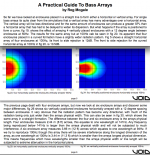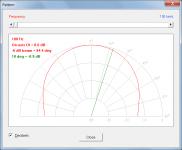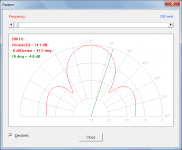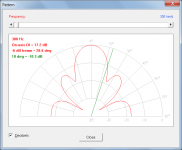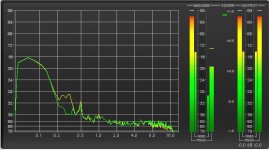Nice. Not lazy.
But now is time to rent some speakers and see what kind of levels are needed, locations, sound, and all kinds of issues that nobody can guess (like why you can't hear much bass out in backyard).
B.
But now is time to rent some speakers and see what kind of levels are needed, locations, sound, and all kinds of issues that nobody can guess (like why you can't hear much bass out in backyard).
B.
But now is time to rent some speakers and see what kind of levels are needed, locations, sound, and all kinds of issues that nobody can guess (like why you can't hear much bass out in backyard).
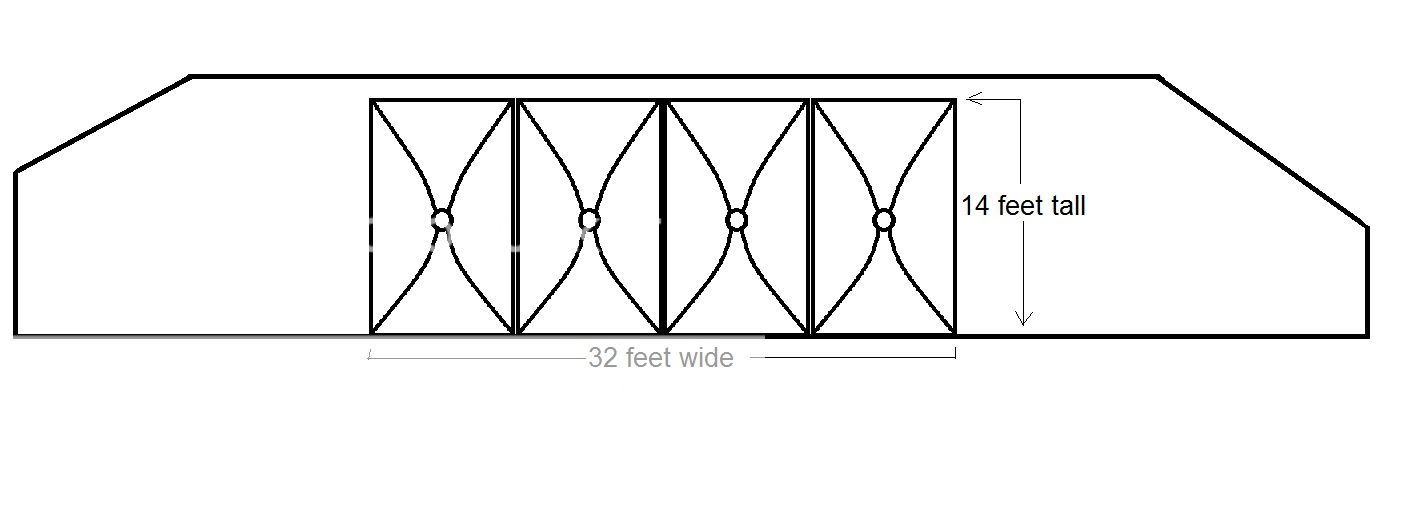
Hornresp simulations show that I can hit over 140 dB at the mouth of each horn, if I stuff (qty 4) 18" B&C drivers into each throat. My first driver iteration will specifically not be (qty 4) 18" per horn. Thankfully the driver arrangement is a design variable I can change, without having to take a jackhammer to my concrete. Thus I do not anticipate a lack-of-bass being an issue. These are big horns, and I'm planning a relatively near-field listening area. I am more worried now about building some compatible mids & highs, and where to physically position them.
1)No, never did I suggest you use more than one bass horn per side. If you want to follow Rog Mogale's advice for multiple subs, you use a vertical array. As I have said like a dozen times now, your design choices are yours, as is obviously the building of whatever you decide upon.1)You suggest that I turn my horns on their side, and build 8 feet wide, 32 feet tall concrete horns?
2)In a Class II earthquake zone?
3)Who's wearing the dunce-cap now weltersys?
4) A while back, a recommendation was made to introduce a center channel & some rear channels, and install a large screen above the horns. I must admit - this would make for a pretty cool movie watching setting. I’m still open to this idea. For a THX type application, I could switch the horns over to play as a mono sub, and turn on the center channel & surrounds. For playing music, I could switch the bass horns back to stereo, and simply shut off the center channel & surrounds. Who knows – maybe it would still sound good with the center channel running???
5) Unless I find something better (at reasonable cost), I’m looking at purchasing DSS Soundweb delays & crossovers.
6) Ben said the same thing. I purchased a DBX Aural exciter long ago, and I still really like it. If the sound is too dry, I will absolutely add moisture. .. . Maybe not necessarily with the DBX, but I’m open to signal conditioning. (I’ve been told by the purists that effects processors are cheating. . ..)
7) Almost every old audio reference (with a chapter on horn design) talks about how awesome “rigid” full size horns are. I’m assuming the authors are not speculating on how awesome they sound – that they’ve actually heard one??? One would think there’d be at least several dozen full size rigid horns in existence - within the US alone. . . .
In case any one reading cares- I have advocated one, and only one bass horn per side (with whatever driver complement required for one's desired SPL at any given frequency) for the reproduction of stereophonic source material from the beginning of this thread.
2)That's your chosen location, you have indicated you will comply with applicable code.
3) Eric, you have not answered a single question I have asked attempting to help you.
You don't bother to read more than a few words in a post, and then jump to conclusions.
It appears a “rigid” full size horn hat is still cemented on your head.
4) It is a good use of a system, watching movies outdoors with a good 5.1 or greater system can be very enjoyable.
The center and surround speakers can be used to add reverberation or echo to the mains, with effects algorithms you can recreate "virtually" any acoustical environment in the physical world, and "trippy", out-of this world experiences.
5) I believe you did a typo, "DSS" rather than "BSS". I have been using BSS (Brooke-Siren Systems) processing since 1981, purchased a BSS Blu 100 a few years back.
Using BSS "London Architect", one can assemble any combination of of EQ, delay and dynamic range modifiers in any sequence the designer decides is appropriate.
You can then "recall" a variety of setups, "Stereo", "Theater", "Loudness Contour", "Rock & Roll Haystack", etc.
6) The "Aural Exciter" is an emulation of "Aphex" units popular for processing vocal tracks, it adds even order harmonic distortion to the upper portion of the "vocal range".
My preference for ambience effects has varied from Lexicon to TC Helicon.
After Bonnie (within a few months of my age) confirmed that a $300.00 TC Helicon "sounded better" (the "rooms" or "halls" or "arenas" sounded more real, with less digital artifacts) than Lexicon's PCM90, a virtual "greatest hits" of the sounds available in Lexicon units that used to cost $10,000.00, I have only used TC Helicon and various old DDL units for "stand alone" effects processors for the last 10 years. That said, there are literally thousands of "plug in" effects to choose from.
7) Eric, not only have the authors, myself, William and millions of others heard "full size" horns, your wife's horns are "full size" for around 1500 Hz up- they may sound "awesome" if they were well-designed and well-built, as most of Radian's product is.
A "full size" horn for 30 Hz would be half the size of a 15 Hz horn, and a "full size" 60 Hz horn like PA companies commonly lugged around in the "dinosaur era" of the early has been depicted in my posts.
There have been dozens of posts showing "full size" horns in your thread, but not any 15 Hz horns with a "full size" mouth, which would have to be 75' in diameter.
A 75' diameter horn would be some "man sized action", it would have 90 degree directionality at Fc, using no processing.
Have fun,
Good Luck,
Art
Last edited:
Yes, ten-million reasons not to pre-test.Hornresp simulations show...
Why does this thread keep on reminding me of the organ speaker thread that ended so badly?
B.
That is approximately front row SPL at a Red Hot Chile Peppers show during the drum solo, when Dave Rat lets the system "redline".Hornresp simulations show that I can hit over 140 dB at the mouth of each horn, if I stuff (qty 4) 18" B&C drivers into each throat.
It is fun to "drive" big sound rigs 😀😀
'Your 'Carrot' is Big Enough, but Your 'Stick' Leaves you Wanting!
There was no mention of Live Performances here but now that you mention it .... You might consider Karaoke; however, just don't do it from the hot tub. I have hosted several song writer performances from my home with 100+ aficionados in attendance. My advice, if you are socially inclined, add a mixer and some mikes for a lot of fun and memorable experiences far outside the 'just acoustics' realm.
All that is needed is a computer, software, and very good sound cards.
So what? Who cares? (Rhetorical Questions) Many of the CDs you play have a lot of effects processing injected into them already.
It represents nothing more than the exercise of Artist and Producer's license.
Not to my knowledge, only some world-wide at about 1/8 the size of what you are talking about. And, yes they do sound "awesome" in spite of their much smaller size. After a certain critical size is reached, it does not matter how much bigger it is, unless you are trying to build a big boat in your small basement!
WHG
>snip<
(2) I don't know any bands, nor do I own any live mixing equipment. The odds of live music being played at my house are extremely low. My primary signal source will be CD recordings (digital files). A while back, a recommendation was made to introduce a center channel & some rear channels, and install a large screen above the horns. I must admit - this would make for a pretty cool movie watching setting. I’m still open to this idea. For a THX type application, I could switch the horns over to play as a mono sub, and turn on the center channel & surrounds. For playing music, I could switch the bass horns back to stereo, and simply shut off the center channel & surrounds. Who knows – maybe it would still sound good with the center channel running???
There was no mention of Live Performances here but now that you mention it .... You might consider Karaoke; however, just don't do it from the hot tub. I have hosted several song writer performances from my home with 100+ aficionados in attendance. My advice, if you are socially inclined, add a mixer and some mikes for a lot of fun and memorable experiences far outside the 'just acoustics' realm.
(4) Unless I find something better (at reasonable cost), I’m looking at purchasing DSS Soundweb delays & crossovers.
All that is needed is a computer, software, and very good sound cards.
(5) >snip<
(I’ve been told by the purists that effects processors are cheating. . ..)
So what? Who cares? (Rhetorical Questions) Many of the CDs you play have a lot of effects processing injected into them already.
It represents nothing more than the exercise of Artist and Producer's license.
(6) Strange, right? Almost every old audio reference (with a chapter on horn design) talks about how awesome “rigid” full size horns are. I’m assuming the authors are not speculating on how awesome they sound – that they’ve actually heard one??? One would think there’d be at least several dozen full size rigid horns in existence - within the US alone. . . .
Not to my knowledge, only some world-wide at about 1/8 the size of what you are talking about. And, yes they do sound "awesome" in spite of their much smaller size. After a certain critical size is reached, it does not matter how much bigger it is, unless you are trying to build a big boat in your small basement!
WHG
Last edited:
Ben,Yes, ten-million reasons not to pre-test.
Why does this thread keep on reminding me of the organ speaker thread that ended so badly?
B.
As I recall, the organ thread ended with an organist that for the most part was satisfied with his "organic" speaker system.
Like Eric, it took the organist hundreds of posts to understand audio basics, like gain structure- it was hilarious to have him complain the low register "lacked authority", when his amp's lowest indicator light barely flickered- he had 24 dB headroom left, and was soliciting new bass designs.
Eric is still posting drawings with his multiple subs in a horizontal array, diametrically opposed to the advice he supposedly took from Void, not realizing he has inverted what Rog suggested.
Four "horizontally positioned enclosures vertically arrayed" is the taller "line array" (technically a vertical array) configuration which has a wide beam-width.
Four "vertically positioned enclosures horizontally", as Eric has been doggedly clinging to like a chew toy since the troll told him what he should be dooing, is the wider side by side configuration with the "bad" comb filtering..
This cement train wreck is a laugh a minute, the reason so many "stay tuned" 🙂
Cheers,
Art
Attachments
This cement train wreck is a laugh a minute, the reason so many "stay tuned" 🙂 Art
Constantly saying I’m doing it wrong, isn’t exactly helping me to do it right. . . . If you’ve got a better idea, why not post a sketch - and clearly convey your design recommendation?
In case any one reading cares- I have advocated one, and only one bass horn per side (with whatever driver complement required for one's desired SPL at any given frequency) for the reproduction of stereophonic source material from the beginning of this thread.Constantly saying I’m doing it wrong, isn’t exactly helping me to do it right. . . . If you’ve got a better idea, why not post a sketch - and clearly convey your design recommendation?
Eric,
Your horn sketch is OK, just use only one per side beneath the mains, toed in, and the most trivial portion of your system is done.
To finish the rest of the system, just build a pair of SynTripP cabinets (the plans are in the thread) from concrete, aluminum, nylon, whatever floats your U- boat, and you are done.
A sketch of a horn will not help you read,- there were sketches of folded horns (my preferred embodiment for stereo subs) presented previously.
Since you don't bother to answer the questions needed to "help" you we can't.
Eric, whether what you are doing is "right" depends on your goals.
It seems you are not after a sound system design, just multiple giant horns that will use more material than most.
Good luck with that.
Art
Last edited:
I see only one argument justifying this stereophonic aspect in sub range. Even good sub got high distortion levels, with harmonics generated content >150hz. Even only h2 at 80hz= 180hz, h3 at 80hz=240hz, where ear is more sensible than in lower freq, and where sound can be localized. So you can get < 100hz imagine from it distortion separation. Weird but interesting concept ^^
Last edited:
Just another remark on "organ speakers".
Hi Y'all,
There have been a number of mentions of "...organ speaker thread...". Just as a reminder, there were three threads here on the diyaudio subwoofer forum, and multiple threads on the 'organforum.com'. Let's try a little comparison, in no particular sequence:
- the environments (small church v. open field)
- available space (very restricted space w/ limited access v. open field)
- financing (very limited budget v. very flexible and expandable budget)
- design goals (repair and augmentation of an existing speaker complement for an organ hybridization project v. building the closest possible to theoretical ideal bass horn as part of an outdoor music playback system)
- project control (organist plus church committee v. individual control)
And the outcome:
From the organforum.com by Bach-On, 02-12-2016: "... the speaker system is working very well. The homemade bass speakers are providing excellent reproduction of the pedal sounds. The bass goes smoothly down to the lowest C on a 32 foot stop...The speakers we have seem to handle all the sounds without breaking a sweat. As you may recall, all our speakers were used Allen speakers except for the two bass speakers I built..."
So, in the organ speaker project we seem to have an OP who is quite happy with the outcome. Would we-as the community-have liked to see measurements of the final outcome? Sure. But, if Entropy455 ends up with a system reflecting his expectations, or maybe just "working very well", all would be good with me.
Regards,
Hi Y'all,
There have been a number of mentions of "...organ speaker thread...". Just as a reminder, there were three threads here on the diyaudio subwoofer forum, and multiple threads on the 'organforum.com'. Let's try a little comparison, in no particular sequence:
- the environments (small church v. open field)
- available space (very restricted space w/ limited access v. open field)
- financing (very limited budget v. very flexible and expandable budget)
- design goals (repair and augmentation of an existing speaker complement for an organ hybridization project v. building the closest possible to theoretical ideal bass horn as part of an outdoor music playback system)
- project control (organist plus church committee v. individual control)
And the outcome:
From the organforum.com by Bach-On, 02-12-2016: "... the speaker system is working very well. The homemade bass speakers are providing excellent reproduction of the pedal sounds. The bass goes smoothly down to the lowest C on a 32 foot stop...The speakers we have seem to handle all the sounds without breaking a sweat. As you may recall, all our speakers were used Allen speakers except for the two bass speakers I built..."
So, in the organ speaker project we seem to have an OP who is quite happy with the outcome. Would we-as the community-have liked to see measurements of the final outcome? Sure. But, if Entropy455 ends up with a system reflecting his expectations, or maybe just "working very well", all would be good with me.
Regards,

Entropy455, others,
Please refrain from personal attacks in the forums. You can discuss an idea or principle, but taking this to the level of personal attacks does put you in conflict with our rules. Try and keep things more professional.
Consider this a warning

-Chris
Respectfully.....is quite useless unless something is built AND MEASURED.
Remember the organ speaker thread........
We'll have to 'agree to disagree', though of course seeing the 'fruits of one's labor' to affirm what's real, mostly right or flat out BS is always 'icing on the cake'. 😉
That said, I've yet to learn anything WRT horn/system design, especially WRT to the OP's super sized stereo system other than about concrete construction beyond my limited poured pad, foundation experience, but hope springs eternal. 😉
Yeah, was a bit disappointed, but still learned a few more tidbits about modern organ design, so worthwhile to me. The main thing is to quick skip over all the 'noise' for anything of interest, then go do something useful elsewhere for awhile. 😉
GM
Hi Bill,
Another good reason to limit the frequency range of the bass horn system to no more than three octaves (15Hz to 120Hz), and preferably even less 🙂.
The attachments show the predicted horizontal directivity patterns for the "conical" horns at frequencies of 100Hz, 200Hz and 300Hz. With the proposed three horn system, the listener is in effect positioned 18 degrees off the axis of each of the outer horns. As I understand it, the actual listening position will be in the near-field not the far-field. Not sure if that makes things better or worse 🙂.
That's what makes this project so interesting and exciting - for me at least 🙂.
Kind regards,
David
So long as the radiation pattern is uniform over the coverage angle for the frequencies of interest, a small toe-out makes no difference.
Another good reason to limit the frequency range of the bass horn system to no more than three octaves (15Hz to 120Hz), and preferably even less 🙂.
The attachments show the predicted horizontal directivity patterns for the "conical" horns at frequencies of 100Hz, 200Hz and 300Hz. With the proposed three horn system, the listener is in effect positioned 18 degrees off the axis of each of the outer horns. As I understand it, the actual listening position will be in the near-field not the far-field. Not sure if that makes things better or worse 🙂.
The system the OP plans on building when completed will be an acoustic first. As far as I know, no-one has built a horn system this large before, particularly out of concrete.
That's what makes this project so interesting and exciting - for me at least 🙂.
Kind regards,
David
Attachments
Nice pix from David McBean. But again, those diagrams mean little until Eric graphs the 6dB curve on to the dimensions of his backyard. BTW, I'd be awfully happy if my music system had no peaks and dips anywhere as small as 6dB (even 1/6 smoothing).
About that theoretical exercise, my experience from long ago (anticipating the noise from mag-lev trains... 1974) is that the propagation of outdoor sound (and everybody on this forum can recite the simple theory) shows limited respect for theory. (Is a horn mouth 30 feet wide a line source or point source?)
So piling theory on theory and without even trying to plot it on a sketch the backyard...
Ben
About that theoretical exercise, my experience from long ago (anticipating the noise from mag-lev trains... 1974) is that the propagation of outdoor sound (and everybody on this forum can recite the simple theory) shows limited respect for theory. (Is a horn mouth 30 feet wide a line source or point source?)
So piling theory on theory and without even trying to plot it on a sketch the backyard...
Ben
Last edited:
David,1)The attachments show the predicted horizontal directivity patterns for the "conical" horns at frequencies of 100Hz, 200Hz and 300Hz. With the proposed three horn system, the listener is in effect positioned 18 degrees off the axis of each of the outer horns.
2)As I understand it, the actual listening position will be in the near-field not the far-field. Not sure if that makes things better or worse 🙂.
1)I have not been able to keep up with all Eric's posts, but don't recall him mentioning using a "conical" horn expansion, other than his "Dunce Hat" reference.
Did he change his mind about using "exponential" bass horns?
2) The low frequency near-field surrounding a bass horn is a round "bubble" approximately the diameter of the horn mouth, but the size of the bubble is frequency dependent, the "beamy" upper frequencies transition from near-field to far-field after exiting the horn mouth, while the transition from near-field to far-field for a 15 foot diameter horn would be around 75 Hz.
Therefore, at any distance less than 75 Hz, the sound field surrounding a single 15 foot diameter horn would not be uniform.
Any three-horn system that does not use a single driver source location will have gross frequency dependent non-uniformity of response depending on the frequency and center to center distance of both throat and mouth, and to complicate (or ruin) the polar pattern more, the designer must also consider the prior two paragraphs.
Art
Last edited:
What of independently effecting the loading and the waveguiding aspects when using a non-axissymmetrical horn?don't recall him mentioning using a "conical" horn expansion,
...
Did he change his mind about using "exponential" bass horns?
Stereo Bass ???
Who needs it ?
I thought i'd post a screenie of a section of a frequency analysis i did today of Jill Scott - A Long Walk.wav
The whole track didn't vary that much all the way through. As you can see, below 150Hz it's totally Mono ! I tried various other tracks from her & different artists, & the result wasn't a lot different, especially below 100Hz.
As you're main goal is music, you won't miss aircraft/trains etc etc, being panned from L-R & R-L, i would have thought 😉
Who needs it ?
I thought i'd post a screenie of a section of a frequency analysis i did today of Jill Scott - A Long Walk.wav
The whole track didn't vary that much all the way through. As you can see, below 150Hz it's totally Mono ! I tried various other tracks from her & different artists, & the result wasn't a lot different, especially below 100Hz.
As you're main goal is music, you won't miss aircraft/trains etc etc, being panned from L-R & R-L, i would have thought 😉
Attachments
What of independently effecting the loading and the waveguiding aspects when using a non-axissymmetrical horn?
I've seen midrange horns on the market, consisting of two opposing flat conical walls, with two opposing exponential-curved walls, for a combined "proper" exponential area expansion - with a true symmetrical center-axis down the length of the horn. The design intent is to control the sound dispersion field. I can only assume (by the shear number of these types of horns on the market), that this design approach works.
The complexity of my concrete horn construction drops significantly, if I can cast a flat horn top - in lieu of casting a top with a big-time exponential curve. I am currently tinkering with the idea of making the top and bottom horn walls completely flat surfaces, with between 20 and 30 degrees of "conical" taper towards the throat - with my vertical walls formed at the required exponential curvature.
Or said another way, making curved vertical concrete forms are way easier than making curved horizontal forms. As long as I'm not exceeding an excessive conical taper, the top and bottom walls of the horn will be no more difficult than casting a reinforced slab-on-grade. And the vertical walls will be no more difficult than casting a curved reinforced retaining wall, with a tapered height. Obviously the top wall of the horn will require very appreciable stanchion reinforcement from below - to hold up several tons of wet concrete & steel - without deformation of the forms...
I think I've narrowed by bass horn design down to just 3 choices. I'll post sketches this evening. . . .
Thanks
Hi David,
Thanks for the graphs. My recommendation:
c/o: 80 Hz., but still have LCR channel drive signals to allow adjustment of levels and frequency response of each horn.
Also, the seismic integrity of the structure proposed is superior to the alternatives.
Bill
Hi Bill,
Another good reason to limit the frequency range of the bass horn system to no more than three octaves (15Hz to 120Hz), and preferably even less 🙂.
The attachments show the predicted horizontal directivity patterns for the "conical" horns at frequencies of 100Hz, 200Hz and 300Hz. With the proposed three horn system, the listener is in effect positioned 18 degrees off the axis of each of the outer horns. As I understand it, the actual listening position will be in the near-field not the far-field. Not sure if that makes things better or worse 🙂.
That's what makes this project so interesting and exciting - for me at least 🙂.
Kind regards,
David
Hi David,
Thanks for the graphs. My recommendation:
c/o: 80 Hz., but still have LCR channel drive signals to allow adjustment of levels and frequency response of each horn.
Also, the seismic integrity of the structure proposed is superior to the alternatives.
Bill
Last edited:
- Home
- Loudspeakers
- Subwoofers
- Concrete Bass Horn Design Question
